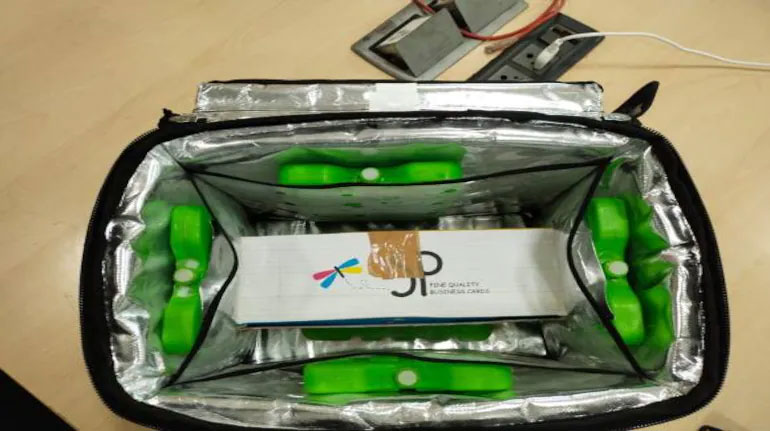How Mumbai-based Tessol is solving cold chain constraints for food companies

The rapidly growing frozen foods market has attracted several companies, old and new, ranging from behemoths like ITC to new-age firms such as BigBasket that have entered the domain but the biggest challenge, however, for these companies remains cold chain infrastructure.
ITC chief Sanjiv Puri acknowledged the challenge in a recent media interaction, saying that to expand the company’s frozen-foods business, it needs to invest in infrastructure, which remains an issue. Tessol founder Rajat Gupta identified this gap as early as 2013, when working with early-stage venture fund Infused based out of IIM-Ahmedabad. The fund focussed on the clean-tech segment, which helped Gupta realise the potential in energy storage. He left the company and founded Tessol in 2013 to work on energy storage and later entered the cold-chain space, focusing on last-mile delivery of frozen products. In a conversation with Moneycontrol, Gupta outlines the journey of Tessol, the problems of cold chain infrastructure in India, and the company’s initiatives.
What challenges do food companies in India face in frozen and chilled foods?
The infrastructure is required at multiple levels in any frozen products business. The first is of course at the factory level; second is to move the products from the factory to a central warehouse, which would have frozen storage capability better known as cold storage. Then from that cold storage, the products need to be brought all the way to the customer. While there is sufficient infrastructure available at the factory level and then for storage later, the challenge comes when companies try to move these products to distributors and also in the last mile delivery. Most distributors lack scale and hence do not want to invest in technologies for the transportation and storage of frozen food products. At the retailer level, too, there are not enough freezers. For the company, moving the products from cold storage to a distributor through a refrigerated vehicle is very expensive because the volumes are very small. So, the refrigerated vehicle becomes an expensive proposition.
What solutions have you built to solve these issues in the cold chain ecosystem?
The concept is similar to that of putting products in ice or ice pack gel to keep them cold. We have built a technology, which is a combination of certain chemicals that freeze and melt at a specific temperature. Our formulations can maintain the temperature at minus 26 degrees, or minus 18 degrees, minus 11 degrees. So, ice melts at over zero degrees and freezes at zero degrees and when ice is added to a drink, it will become cold. If you put a product along with ice pack gel, it will maintain the temperature in the range of 10-12 degrees Celsius. Our technology is a combination of these chemicals and the enclosures or insulated boxes that can maintain a particular temperature to store products such as seafood or Shrikhand.
The third part is how you bring the product, unspoiled to the customer. Our understanding of the cold chain market is that as you move into the last mile, the capacity utilization goes down for refrigerated vehicles because you won’t have a complete load. Even top brands in the segment do not have large distributors, who will take a refrigerated vehicle to a retailer. As a result, the companies either don’t use refrigeration or do not cater to customers or retailers beyond a certain range as it becomes expensive.
Our technology is independent of the vehicle. A small delivery of one kilogram can be packed in a bag and delivered to homes. The companies can actually directly cater from the main warehouse to their retailers. It also enables companies to send a combination of products such as frozen, chilled, or ambient in the same vehicle or truck, which require different temperatures, to an HoReCa partner.
How cost-efficient is this solution?
Companies spend Rs 45,000 a month for the transportation of ambient products, however, a refrigerated truck (of 1 tonne) costs around Rs 85,000-90,000 a month, while with our technology the expense would be around Rs 55,000-60,000 per month. From a transportation standpoint, there could be a potential 30-35 percent cost saving.
Packaged food including frozen foods have witnessed an upsurge in the last 18 months as consumers stay at home. Have you benefited from this trend?
Packaged foods have definitely seen an uptake. More than frozen foods, chilled food is more common in India. And transportation of chilled food is even more challenging than frozen food as it has a limited shelf life. For example, chicken spoils very quickly if the temperature goes up. So, due to the pandemic, we have seen an increase in the volume of current customers and also seen a lot more brands coming up with direct-to-consumer models. And therefore, require these kinds of solutions.
These product segments have remained a metro phenomenon so far. Do you foresee this changing?
We have seen large e-commerce companies expanding to smaller cities. They have not entered lower tiers, but are trying in most of the state capitals. Several local brands have also mushroomed in these smaller cities, which are offering frozen food or chilled products. Hence, the demand has grown up again, you can’t compare it to Bombay, Delhi, or Bangalore. But it’s increasing.
The entire segment is growing at 15 percent CAGR. However, e-commerce has seen rapid growth and the segment is growing close to 70-75 percent every year on the digital channel. Poultry is another industry that is growing very quickly, as consumers move to organized poultry rather than local butcher shops. Hence, companies such as Licious, TenderCuts, FreshToHome are witnessing increased traction. Another area where we have seen increased demand for our services is confectionaries such as chocolates. Several artisan chocolates brands have come up in the market of late.
Source: moneycontrol